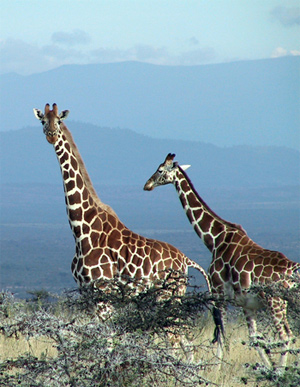|
|
The disappearance of elephants, giraffes and other grazing animals from the eastern African savanna could send ecological ripple effects all the way to the savanna’s ants and the acacia trees they inhabit, warns a new study published in the journal Science.
Researchers have long known of mutualisms — in which two unrelated species depend directly on each other — but “are just beginning to understand how other components of an ecosystem can affect these relationships,” according to a statement from Science. The new research, led by Todd Palmer, an assistant professor of zoology at the University of Florida, suggests that small changes in species composition can have dramatic impacts throughout the ecosystem.
 Giraffes around the ant-plant, Acacia drepanolobium. Image courtesy of Todd Palmer  Scale-tending by an ant species. One of the ways in which the mutualism breaks down is that ants become more antagonistic towards plants by increasing their tending of these parasitic scale insects. Image courtesy of Todd Palmer |
Fencing off areas of acacia trees at a study site in Kenya, Palmer and colleagues found that when protected from herbivores, some Acacias declined. The results, seemingly counterintuitive, result from a mutualistic relationship between acacia trees and ants. The acacias provide food (in the form of nectaries) and shelter (at the base of thorns on the acacia tree) for three species of ants, while the insects offer protection for the tree against pests like stem-boring beetles.
The scientists found that when elephants, giraffes and other large mammals could no longer graze on the acacias, trees produced less nectar to support aggressively defensive ant species. Thus ant colony size decreased and a less protective, fourth ant species became dominant over the others. The acacias then became vulnerable to scale insects and wood-boring beetle whose cavities serve as a home for the useless fourth species of ant. Overall the researchers found that fenced trees were twice as likely to die as the unfenced ones and grew 65 percent more slowly.
“If you get rid of the large mammals, it shifts the balance of power, because the trees default on their end of the bargain,” said Palmer. “When the trees opt out, their hard-working employees starve and grow weak, which causes them to lose out. So, ironically, getting rid of the mammals causes individual trees to grow more slowly and die younger.”
“Throughout sub-Saharan Africa these large mammals are threatened by human population growth, habitat fragmentation, over-hunting, and other degradation, so we have to wonder how their loss will affect these ecosystems,” explained Palmer. “It’s becoming increasingly clear that anthropogenic change can have rapid and unanticipated consequences for cooperative species interactions, and we caught this happening in real time.”
Palmer, T.M. et al (2008). Breakdown of an Ant-Plant Mutualism Follows the Loss of Large Herbivores from an African Savanna. Science 11 January 2008